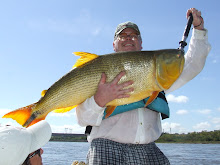
Alligator gar are the largest of the 7 known gar species. These gar get enormous reaching lengths of possibly 10 feet and weighing over 300 pounds.
Alligator gar have been in existance for years swimming with the dinosaurs. However, today they live in only North and Central America and have been introduced into a few ponds in Thailand.
These behemouths are generally green in coloration and have a heavily scaled body. They have an alligator-like snout with hundreds of needle-sharp teeth.
Recently many large alligator gar have been landed from the Trinity River, Texas.
In earlier years, alligator gar were considered "dangerous" and were reported to attack humans. Many thought this predator destroyed game fish stocks so there were large scaled commerical fishing to get rid of these beasts.
However due to its recent exposure on television, alligator gar are now protected by law.
The current IGFA record was landed by Bill Valverde while fishing the Rio Grande in Texas during 1951. The monster weighed 279lbs. However, reports are the Kenny Williams landed monster alligator gar weighing 327lbs that had a length of 8 1/2 feet and girth of 47.95 inches on Feburary 2011 while fishing Lake Chotard in Mississippi









































